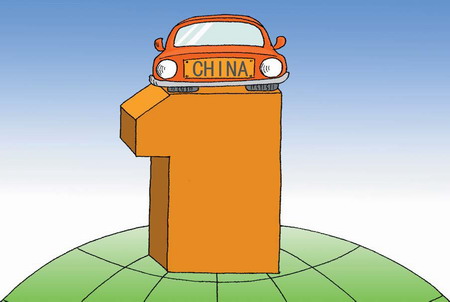Photos
Moving forward
Updated: 2011-01-14 10:13
By Yubing and Wang De'an (China Daily European Weekly)

Chinese auto sector is set for stable, sustainable growth
Despite Beijing's decision to phase out tax incentives and restrict new car sales in the capital, China's auto industry can expect stable and sustainable growth in 2011 thanks to economic recovery both at home and abroad.
In 2011, the sales volume of automobiles is forecast to increase by 12.4 percent to 20.32 million units, with capacity utilization declining, profits for car companies rising and overall industry profits remaining basically stable.
The most prominent segment increases will be among sport utility vehicles (SUV), multi-purpose vehicles (MPV) and motor coaches. Heavy truck sales will continue to grow at 10 percent, while sedans will enjoy a 13.5 percent annual sales boost.
During the second half of 2010, there were substantial increases in the price of raw materials such as non-ferrous metals, natural rubber and crude oil and these rises will impose cost pressures on auto companies.
Labor costs will also increase by 30 percent in 2011 but given that labor only counts for 4 to 5 percent of production costs, the gross profit for car companies will only fall by 1.1 percent.
Salaries among high-tech workers are also set to rise. Foxconn Technology Group, the Taiwanese-owned electronics company that supplies products to Apple and other multinationals, is planning to raise salaries and will move plants to the inland areas.
In the third quarter of 2010, BYD and Yutong Group also raised employee salaries.
In 2010, major provinces in China adjusted the minimum wage and rate rises were higher than 20 percent.
The highest average rate rise of 37 percent occurred in Hainan province while the highest minimum wage - 1,120 yuan per month - was set in Shanghai.
In 2010, we predicted that the capacity utilization of sedan manufacturers reached the highest point in recent years - 104 percent - and some enterprises were even stretched to 130 percent.
At the same time, the profit rate before tax of key enterprises groups was higher than 10 percent compared to the average rate of 6 percent between 2002 and 2009.
The rapid growth of the auto industry in past two years has prompted automobile companies to expand their businesses and set up more production centers. Capacity utilization will drop to 98 percent with the incoming increase of market supply.
Beijing has gradually eroded tax incentives for small-engine vehicles, a plan that was introduced in 2008 to help the Chinese economy recover from a temporary hiatus as a result of the worldwide financial crisis.
We think this initiative helped establish a healthy and sound automobile trade market.
The rapid growth of China's automobile market in 2009 was spurred by the preferential policies and the increase in residential income.
From the fourth quarter in 2008, the government issued a series of fiscal and taxation policies to boost the development of the auto industry, expand domestic demand, save energy, reduce emissions, and ensure steady and relatively fast economic development.
Those policies were quite necessary and encouraged a boom in the auto industry.
Today, the auto industry has developed its own momentum and does not need these supportive policies anymore.
However the rapid growth of car sales has raised concerns regarding the environment and traffic congestion.
In regards to exports, China's auto industry has enjoyed a rapid rise. The compound growth rate from 2004 to 2008 was 71.8 percent.
In 2008, China exported 685,000 automobiles accounting for 7.3 percent of national sales and only 3 percent in world exports.
The export of joint-venture brand vehicles is always limited by market segmentation and each company's global strategy and this has allowed Chinese brands to more easily expand their overseas markets.
In 2009, from January to November, the top 10 sedan-making enterprises with the highest export volumes all have their own brands.
These export pioneers have enhanced their advantages in cost performance, operation systems, export experience, public praise, sales networks and human resources.
Today the strategic focus of the auto industry begins to shift from large-scale operations to stronger competitiveness.
The overall goal of 12th-Five-Year Plan of the auto industry emphasized the shift.
On the one hand, we advocate the development of energy-saving motor vehicles including new energy-powered automobiles.
On the other, we advocate solving the problems of production capacity surpluses by merging and reorganizing car companies.
The key words of the 12th-Five-Year Plan of the auto industry are innovation, energy-saving, merging and reorganization.
The authors are analysts of Ping An Securities Limited.
E-paper

Ear We Go
China and the world set to embrace the merciful, peaceful year of rabbit
Preview of the coming issue
Carrefour finds the going tough in China
Maid to Order
Specials

Mysteries written in blood
Historical records and Caucasian features of locals suggest link with Roman Empire.

Winning Charm
Coastal Yantai banks on little things that matter to grow

New rules to hit property market
The State Council launched a new round of measures to rein in property prices.
